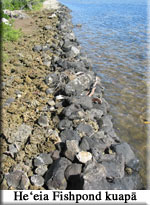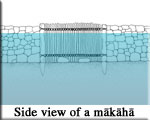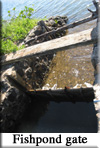| Physical
Features of He'eia Fishpond
The
main physical features of He'eia Fishpond include seawalls (kuapa),
gates and sluice grates (makaha) , and guard houses (hale
kia'i). 
The
purpose of the kuapa was to divide the sea or stream from the
water inside of the fishpond. Sometimes, secondary inner walls were
built to separate and protect the young fish (pua) from predators
within the main area of the fishpond. He'eia Fishpond wall lengths ranged
between 3 feet to 40 feet wide in various places (Henry, 1993).
 Through
observation of He'eia Fishpond kuapa today, you would find
many large pieces of coral among the lava rock. It is possible that
the Hawaiians were aware of the characteristics of coralline algae,
a lime-secreting seeweed that was a natural binding agent on reefs.
As a result, coralline algae would "cement" together portions
of the coral and rock fill so that the fishpond wall was strengthened
(Summers, 1964). Through
observation of He'eia Fishpond kuapa today, you would find
many large pieces of coral among the lava rock. It is possible that
the Hawaiians were aware of the characteristics of coralline algae,
a lime-secreting seeweed that was a natural binding agent on reefs.
As a result, coralline algae would "cement" together portions
of the coral and rock fill so that the fishpond wall was strengthened
(Summers, 1964).
 The
makaha is a grate or grill placed in an opening in the rock
wall. It is constructed of upright sticks tied to two or three cross
beams. The makaha allows both water and pua to enter
the fishpond while keeping undesirable fish (such as predators) out.
Construction of a makaha always began with a religious ceremony by the
priest (kahuna) of the family gods ('aumakua). He
offered prayers and gifts to increase fish productivity. Then the kahuna
would reach for a timber and set it up for the building of the makaha
followed by a closing prayer. After the makaha was built, foundation
stones and pebbles were laid on the bottom (Summers, 1964). The
makaha is a grate or grill placed in an opening in the rock
wall. It is constructed of upright sticks tied to two or three cross
beams. The makaha allows both water and pua to enter
the fishpond while keeping undesirable fish (such as predators) out.
Construction of a makaha always began with a religious ceremony by the
priest (kahuna) of the family gods ('aumakua). He
offered prayers and gifts to increase fish productivity. Then the kahuna
would reach for a timber and set it up for the building of the makaha
followed by a closing prayer. After the makaha was built, foundation
stones and pebbles were laid on the bottom (Summers, 1964).
 Ancient
makaha were built to be unmovable. Addition of a solid gate
in combination with the makaha evolved later. With the makaha
in place, the solid gate was used to control the flow and water level
in the pond without releasing any fish. When the gate was opened at
high tide, water would flow into the pond. When the gate opened at low
tide, the fishpond was drained and this helped clean the pond. The opening
of the gates also permitted trapping of fish making it easier for the
fishpond operator (Henry, 1993). Ancient
makaha were built to be unmovable. Addition of a solid gate
in combination with the makaha evolved later. With the makaha
in place, the solid gate was used to control the flow and water level
in the pond without releasing any fish. When the gate was opened at
high tide, water would flow into the pond. When the gate opened at low
tide, the fishpond was drained and this helped clean the pond. The opening
of the gates also permitted trapping of fish making it easier for the
fishpond operator (Henry, 1993).
Hale
kia'i are guard houses that was not a residence, but instead a
shelter for the fishpond keeper (ki'ai loko) while he was on
patrol. Each fishpond had one or more ki'ai loko who reported
to the konohiki. They patrolled the pond, cleaned it, and harvested
the fish (Henry, 1993).
|





